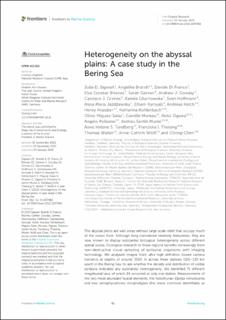| dc.contributor.author | Sigwart, Julia D. | |
| dc.contributor.author | Brandt, Angelika | |
| dc.contributor.author | Di Franco, Davide | |
| dc.contributor.author | Escobar-Briones, Elva | |
| dc.contributor.author | Gerken, Sarah | |
| dc.contributor.author | Gooday, Andrew J. | |
| dc.contributor.author | Grimes, Candace J. | |
| dc.contributor.author | Gluchowska, Kamila | |
| dc.contributor.author | Hoffmann, Sven | |
| dc.contributor.author | Jazdzewska, Anna Maria | |
| dc.contributor.author | Kamyab, Elham | |
| dc.contributor.author | Kelch, Andreas | |
| dc.contributor.author | Knauber, Henry | |
| dc.contributor.author | Kohlenbach, Katharina | |
| dc.contributor.author | Miguez-Salas, Olmo | |
| dc.contributor.author | Moreau, Camille | |
| dc.contributor.author | Ogawa, Akito | |
| dc.contributor.author | Poliseno, Angelo | |
| dc.contributor.author | Santin Muriel, Andreu | |
| dc.contributor.author | Tandberg, Anne Helene Solberg | |
| dc.contributor.author | Theising, Franziska I | |
| dc.contributor.author | Walter, Thomas | |
| dc.contributor.author | Wölfl, Anne-Cathrin | |
| dc.contributor.author | Chen, Chong | |
| dc.date.accessioned | 2023-02-07T10:01:46Z | |
| dc.date.available | 2023-02-07T10:01:46Z | |
| dc.date.created | 2023-01-24T10:58:44Z | |
| dc.date.issued | 2023 | |
| dc.identifier.issn | 2296-7745 | |
| dc.identifier.uri | https://hdl.handle.net/11250/3048816 | |
| dc.description.abstract | The abyssal plains are vast areas without large scale relief that occupy much of the ocean floor. Although long considered relatively featureless, they are now known to display substantial biological heterogeneity across different spatial scales. Ecological research in these regions benefits increasingly from non-destructive visual sampling of epifaunal organisms with imaging technology. We analysed images from ultra-high-definition towed camera transects at depths of around 3500 m across three stations (100–130 km apart) in the Bering Sea, to ask whether the density and distribution of visible epifauna indicated any substantial heterogeneity. We identified 71 different megafaunal taxa, of which 24 occurred at only one station. Measurements of the two most abundant faunal elements, the holothurian Elpidia minutissima and two xenophyophores morphotypes (the more common identifiable as Syringammina limosa), indicated significant differences in local densities and patchy aggregations that were strikingly dissimilar among stations. One station was dominated by xenophyophores, one was relatively depauperate in both target taxa as well as other identified megafauna, and the third station was dominated by Elpidia. This is an unexpected level of variation within comparable transects in a well-mixed oceanic basin, reinforcing the emerging view that abyssal habitats encompass biological heterogeneity at similar spatial scales to terrestrial continental realms. | en_US |
| dc.language.iso | eng | en_US |
| dc.title | Heterogeneity on the abyssal plains: A case study in the Bering Sea | en_US |
| dc.title.alternative | Heterogeneity on the abyssal plains: A case study in the Bering Sea | en_US |
| dc.type | Peer reviewed | en_US |
| dc.type | Journal article | en_US |
| dc.description.version | publishedVersion | en_US |
| dc.source.journal | Frontiers in Marine Science | en_US |
| dc.identifier.doi | 10.3389/fmars.2022.1037482 | |
| dc.identifier.cristin | 2113875 | |
| cristin.ispublished | true | |
| cristin.fulltext | original | |
| cristin.qualitycode | 1 | |
